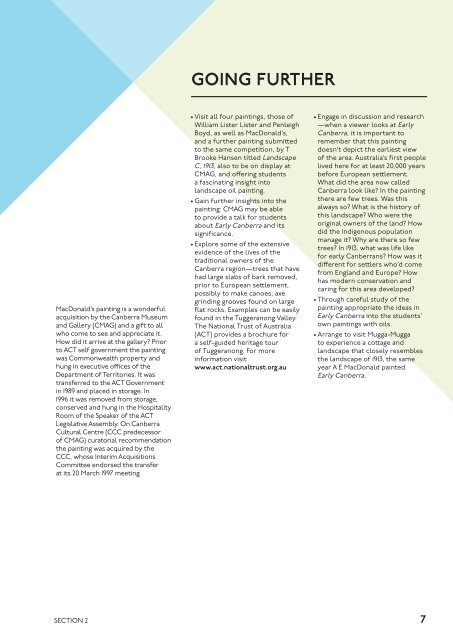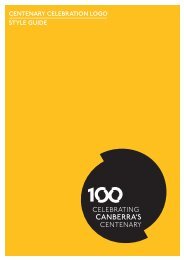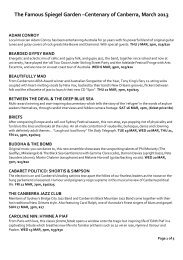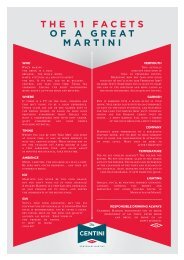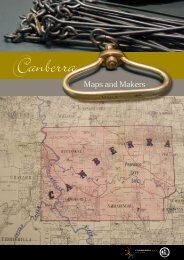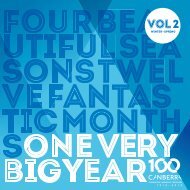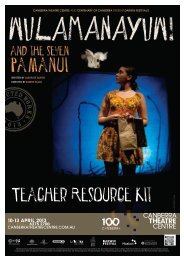THE ART - Canberra 100
THE ART - Canberra 100
THE ART - Canberra 100
Create successful ePaper yourself
Turn your PDF publications into a flip-book with our unique Google optimized e-Paper software.
GOING FUR<strong>THE</strong>R<br />
MacDonald’s painting is a wonderful<br />
acquisition by the <strong>Canberra</strong> Museum<br />
and Gallery (CMAG) and a gift to all<br />
who come to see and appreciate it.<br />
How did it arrive at the gallery? Prior<br />
to ACT self government the painting<br />
was Commonwealth property and<br />
hung in executive offices of the<br />
Department of Territories. It was<br />
transferred to the ACT Government<br />
in 1989 and placed in storage. In<br />
1996 it was removed from storage,<br />
conserved and hung in the Hospitality<br />
Room of the Speaker of the ACT<br />
Legislative Assembly. On <strong>Canberra</strong><br />
Cultural Centre (CCC predecessor<br />
of CMAG) curatorial recommendation<br />
the painting was acquired by the<br />
CCC, whose Interim Acquisitions<br />
Committee endorsed the transfer<br />
at its 20 March 1997 meeting.<br />
••<br />
Visit all four paintings, those of<br />
William Lister Lister and Penleigh<br />
Boyd, as well as MacDonald’s,<br />
and a further painting submitted<br />
to the same competition, by T<br />
Brooke Hansen titled Landscape<br />
C, 1913, also to be on display at<br />
CMAG, and offering students<br />
a fascinating insight into<br />
landscape oil painting.<br />
••<br />
Gain further insights into the<br />
painting: CMAG may be able<br />
to provide a talk for students<br />
about Early <strong>Canberra</strong> and its<br />
significance.<br />
••<br />
Explore some of the extensive<br />
evidence of the lives of the<br />
traditional owners of the<br />
<strong>Canberra</strong> region—trees that have<br />
had large slabs of bark removed,<br />
prior to European settlement,<br />
possibly to make canoes; axe<br />
grinding grooves found on large<br />
flat rocks. Examples can be easily<br />
found in the Tuggeranong Valley.<br />
The National Trust of Australia<br />
(ACT) provides a brochure for<br />
a self-guided heritage tour<br />
of Tuggeranong. For more<br />
information visit<br />
www.act.nationaltrust.org.au<br />
••<br />
Engage in discussion and research<br />
—when a viewer looks at Early<br />
<strong>Canberra</strong>, it is important to<br />
remember that this painting<br />
doesn’t depict the earliest view<br />
of the area. Australia’s first people<br />
lived here for at least 20,000 years<br />
before European settlement.<br />
What did the area now called<br />
<strong>Canberra</strong> look like? In the painting<br />
there are few trees. Was this<br />
always so? What is the history of<br />
this landscape? Who were the<br />
original owners of the land? How<br />
did the Indigenous population<br />
manage it? Why are there so few<br />
trees? In 1913, what was life like<br />
for early <strong>Canberra</strong>ns? How was it<br />
different for settlers who’d come<br />
from England and Europe? How<br />
has modern conservation and<br />
caring for this area developed?<br />
••<br />
Through careful study of the<br />
painting appropriate the ideas in<br />
Early <strong>Canberra</strong> into the students’<br />
own paintings with oils.<br />
••<br />
Arrange to visit Mugga-Mugga<br />
to experience a cottage and<br />
landscape that closely resembles<br />
the landscape of 1913, the same<br />
year A E MacDonald painted<br />
Early <strong>Canberra</strong>.<br />
SECTION 2<br />
7


